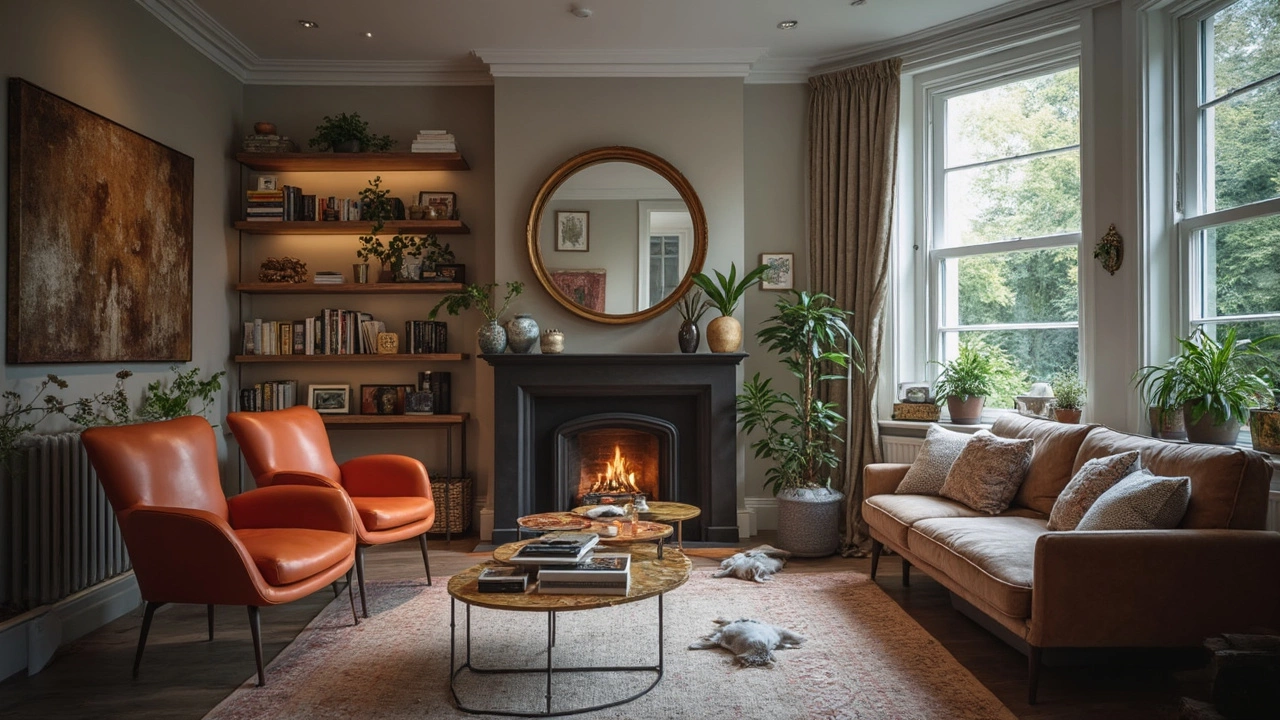Picture this: a home where lights adjust to your mood, thermostats learn your preferences, and security systems are more vigilant than a night owl on caffeine. A few years back, smart home technology was all the buzz, hailed as the future of living. But somewhere along the way, things got complicated.
It wasn't long ago when the idea of managing your home with a tap on your phone felt like living in a sci-fi movie. And it sure did start out as a hit! Smart gadgets flew off shelves as folks rushed to join the automation bandwagon. Fridges that tell you when you're out of milk? Heck, yes! Yet, not all stories have a happy ending. Our wired dreams started to unravel as reality set in, bringing a few surprises along the way.
Ever wonder why those early smart home enthusiasts are now more cautious about their setups? Don't worry, you're not the only one asking. As thrilling as the technology sounds, it hasn't been all roses. Let's dive into the nitty-gritty of what went wrong and whether smart homes can still keep their promise of a safer living space.
- The Promise of Smart Home Technology
- Early Success and Rapid Adoption
- Challenges and Disappointments
- Current State of Smart Home Security
- Tips for Securing Your Smart Home
The Promise of Smart Home Technology
Imagine walking into your house after a long day, and your cozy space just knows what you need—lights dimmed perfectly, your favorite tunes playing softly, and the temperature just right. That's the magic smart home tech promised us. It wasn't just about convenience; it was about creating a living environment that adapted to your lifestyle.
The real game-changer was the promise of beefed-up home security. With smart cameras and sensors, you could watch over your home from anywhere. These systems offered automated alerts and even learned usual patterns to spot odd activities. It was like having your little security guard on duty 24/7. Stats even showed a drop in neighborhood crime rates where smart security was heavy.
Born from the Internet of Things (IoT), smart home tech offered interconnectedness we hadn't seen before. Fridges, ovens, and even washing machines started talking to each other. Remote controlling your devices brought newfound efficiency and customization. Energy savings? You bet, as these systems monitored usage to help you cut costs. Who wouldn't want a lower utility bill?
The dream was big, and early adopters jumped in headfirst, eager to live the futuristic life automation promised. Tech giants poured billions into developing sleeker and more intuitive systems while a flood of startups added innovation into the mix. Every other ad seemed to tout how you could streamline your life with smart gadgets.
From smart bulbs to voice-activated assistants, it felt like the Jetsons' reality was just around the corner. And for a while, it was. But was it all too good to be true? Let's just say there were a few knocks on the road that brought about the real tests of this shiny new tech.
Early Success and Rapid Adoption
Back in the day, when smart home tech was first making waves, it was like something out of a futuristic movie. People were pretty eager to jump on this new trend. Imagine walking into a room and having everything just right without even lifting a finger. It was like magic, but real!
By around 2018, smart home devices weren't just for tech geeks anymore. They were everywhere. You had giant companies like Amazon and Google throwing their hats in the ring with devices like Alexa and Google Home. They made it super easy for everyone to integrate tech into their daily lives.
This boom wasn't just about convenience. People saw these gadgets as must-haves for home security. Suddenly, you could watch your property from anywhere with cameras linked to your phone. No more worrying about leaving the house unattended!
And let's not forget how appealing these gadgets were for the younger crowd. With devices getting cheaper and more accessible, even your grandma was curious about owning a smart thermostat. The user-friendly aspect, combined with some flashy marketing, meant the adoption curve really shot up.
One key stat from those wild days? In 2019 alone, an estimated 45% of Americans owned at least one automation device. Not just that, but there were constant updates making these things smarter and more efficient.
All this buzz had entrepreneurs flooding the market with some truly creative gadgets. The competition was fierce, leading to better products and, weirdly, better prices. But, as the story goes, what goes up sometimes has to come down.

Challenges and Disappointments
Here's where things got tricky for smart home enthusiasts. The promise of a seamless, secure, and connected life hit some snags that have left many scratching their heads. Let's break down some of the major issues that have cropped up.
First off, the issue of security. Ironically, the very systems designed to keep us safe have become a soft target for hackers. With stories of unauthorized access and data breaches, home automation didn't just bring convenience; it brought a slew of privacy concerns. A report by cybersecurity experts found that nearly two-thirds of home security cameras were vulnerable to external attacks. It's like the backdoor got left open!
Then there's the complexity. Sure, who wouldn't want a house that responds to voice commands? But setting up these gadgets can feel like a whole new language, especially for the tech-challenged among us. It's not uncommon for users to abandon devices simply because they're too complicated to use or integrate with other systems.
And speaking of integration, not all devices are created equal. Imagine having a fridge, thermostat, and security camera, each needing a different app, and none of them playing nice together. Lack of standardization means we're left juggling multiple platforms, which is not what most signed up for.
Pricing is another hurdle. While prices have dropped in recent years, a fully automated smart home can still cost a pretty penny. This makes it tough for the average person to justify the expense, especially when weighed against the aforementioned headaches.
| Common Issues | Percentage of Users Affected |
|---|---|
| Security Concerns | 60% |
| Complex Setup and Use | 50% |
| Integration Problems | 40% |
| Cost | 30% |
So yes, while smart home tech looked great on paper, these wrenches in the works showed that the road to the future is a bit bumpier than anticipated. Despite these challenges, many users are still hopeful, and tweaking the system might just smooth things out.
Current State of Smart Home Security
The current landscape of smart home security is a mixed bag. Some gadgets are still revolutionary, while others seem like they're straight from the last decade. One of the bright sides is the continuous advancement in artificial intelligence, making it easier for home security systems to learn and adapt to user behavior.
Today's smart home systems emphasize integration, coupling devices under a unified hub. Platforms like Google Home and Amazon Alexa try to make life a breeze by bringing everything under one roof, digitally speaking. The goal is to make it seamless rather than a tangled web of individual devices.
Yet, the rapid growth of this technology wasn't without hitches. Security risks have become a hot topic, with hackers finding ways to breach these systems. Remember when that famous fish tank was hacked? Yeah, it's becoming a trend, unfortunately. Users must now think twice about the devices they connect to their networks.
There's also the problem of fragmentation. Every company has its own ecosystem, often leading to compatibility issues. You may have a gadget that’s superbly smart but doesn’t play nice with others. That’s a bummer for the “universal control” dream.
Automation technology demands constant updates, but manufacturers sometimes lag in delivering patches, leaving devices vulnerable. Regular firmware updates are crucial to keep devices secure from the ever-evolving cyber threats.
How about costs? Well, these systems aren't exactly dirt cheap. While initial setups can eat into your savings, the market is seeing a gradual decline in prices. This makes home security more accessible, but finding the right balance between cost and capability is like walking a tightrope.
Here's quick glance at some numbers:
| Device | Average Cost (2025) | Compatibility Rating |
|---|---|---|
| Smart Doorbell | $150 | 8/10 |
| Smart Locks | $200 | 7/10 |
| Security Cameras | $100 | 9/10 |
| Smart Hub | $120 | 6/10 |
For the tech-savvy homeowners willing to take these issues in stride, the benefits of a modern smart home system can outweigh the potential risks. Staying informed and cautious is key here. It's always a good idea to keep up with reviews and updates before sealing the deal on your next gadget.

Tips for Securing Your Smart Home
So, you've got a smart home packed with gadgets that do everything except make your morning coffee (though that's probably coming soon). But with all this tech magic comes the chill of potential security risks. Let's make sure your home remains a fortress without unplugging everything.
First things first, make sure your Wi-Fi is locked down tighter than Fort Knox. A strong and unique password isn't just a nuisance—it's your first line of defense. Consider renaming your network to something that doesn't scream "Hey, I'm filled with smart devices!"
Got those default passwords from your gadgets? Change them. And while you're at it, update the device firmware regularly. Manufacturers often patch security flaws, and staying current is key to keeping bad actors at bay.
Next up, let's talk about networks. Many routers offer a guest network option. Use it. Isolating smart home devices from your main network adds a layer of safety. Think of it like putting your valuables in a safe rather than leaving them by the front door.
Also, turn on two-factor authentication (2FA) wherever possible. Yes, it's sometimes annoying to get a code on your phone, but it's a small price to pay for a more secure home security setup.
Consider investing in a solid security system that integrates well with your existing setup. A good system not only guards against physical intrusion but also against digital threats.
| Security Tip | Importance Level |
|---|---|
| Strong Wi-Fi Password | High |
| Update Firmware Regularly | High |
| Use Guest Networks | Medium |
| Enable 2FA | High |
| Change Default Passwords | High |
Finally, get familiar with the data policies of your devices. Many smart gadgets collect usage data. Knowing what's being tracked and opting out if you can is crucial to smart home security.
There you go! Secure your space without throwing tech out the window. By taking these steps, you ensure your home remains both smart and safe.

